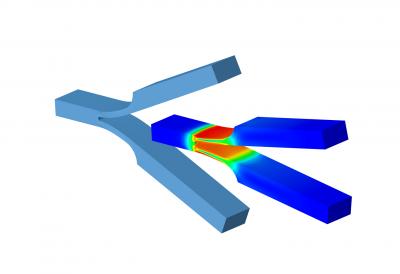This phenomenon is called the shape memory effect and it can be observed in certain metallic alloys, known as shape memory alloys. These kinds of materials are ideal for many applications. In aerospace technologies, solar sails can unfold in outer space. In cardiology, stents are small tube-shaped, metal grid frameworks folded together and inserted into blood vessels where they expand and prevent the vessels from becoming blocked.
However, it is a long road towards creating products using shape memory. The characteristics of shape memory alloys are complex and therefore difficult to predict so engineers must produce many prototypes before they achieve a fully operational component with the desired characteristics.

Simulation of the forceps for medical endoscopy: the colors of the almost closed forceps represent the given forces (high pressure: red, no pressure: blue). Credit: Fraunhofer IWM
Researchers at the Fraunhofer Institute for Mechanics of Materials IWM have found a quicker way to reach their goal: "The numerical simulation which we have developed already answers many questions upfront, long before a prototype exists," explains IWM project manager Dr. Dirk Helm.
With the help of these simulations, the scientists have developed various objects, including a minuscule forceps for endoscopy. Normally, such micro forceps can only be created with joints. How can a component be produced that has such small dimensions, is elastic, can be thoroughly sterilized and has no joints? The computer supplies the answer, with the help of numerical simulation models, the researchers could calculate in advance the most important characteristics of the component, such as its strength and clamping force, and efficiently develop and manufacture the elastic component.
"Normally, many tests with various prototypes would need to be conducted," Dr. Helm explains. "By using simulations, we can avoid producing most of these prototypes. This saves costs because the raw materials for the shape memory alloys are very expensive and are sometimes difficult to work with." In addition, the researchers can estimate through simulations how durable the modern materials are.





Comments